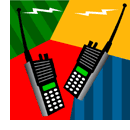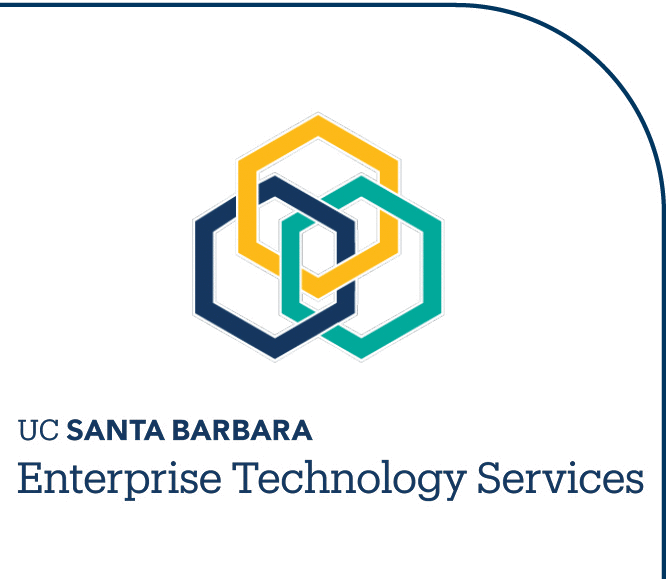

What is an 800MHz radio system?
An 800MHz radio system is a blend of traditional two-way radio technology and
computer-controlled transmitters. The system’s main advantage is that radio
transmitters can be shared among various departments on campus, with the aid of computer
programming. Virtual radio groups called "talk groups" are created in software
to enable private departmental conversations. This gives the new system the appearance of
having many "frequencies," when in fact everyone is sharing only a few.
At least three talk groups besides the departmental one are programmed into every
radio:
- A "COMMON" talk group that allows you to communicate with other departments
for specific events, such as Move-In, concerts, or Commencement.
- A channel for use when the campus activates the Emergency Operations Center.
- A 911 channel for contacting the campus police in the event of an emergency.

Who at UCSB is using this system?
We currently have eighteen groups using the system: The College of Letters and Science, Student Health, Environmental Health & Safety, Facilities Management, Housing & Residential Services, Parking Services, Police, Paramedics, Santa Barbara County Fire Department, Exercise and Sports Studies, Transportation Services, Business Services, KCSB, the Office of Information Technology, the Children's Center, Communications Services, UCen Dining Services, and Senior Officers (during campus emergencies).

Who else uses this type of system?
The UC Regents have approved this system for all UC campuses, and it is now operational
at every site. This allows staff at other campuses to assist in Mutual Aid. The radios
will inter-operate among campuses for emergency situations.

What kinds of portable radios I can buy?
There are four models of handheld radios to choose from: the Utility-Rated MotoTrbo XPR 6580, and the Public-Safety-rated XTS 1500 and 2500 Types I and II. Up to 2005, the campus used the Motorola MTS-2000. In 2005, Motorola discontinued the Public-Safety rated MTS 2000 series and replaced it with the XTS 1500 and 2500 models.

What are the distinctions among the available models?
All the radios have the same power and range, so there is no penalty in performance if you
choose a less expensive model. All can participate in UCSB emergency response and
Emergency Operation Center conditions. However, there are differences.
- The MotoTrbo XPR6580 is the most cost-effective and simple to use, and can scan up to 16 talkgroups programmed into it.
- The Public-Safety-rated XTS 1500 is the least expensive, is simple to use, and can scan up to 16 talkgroups programmed into it.
- The Public-Safety-rated XTS 2500 Type I can also scan frequencies, can have up to 48 "talk groups" programmed into it, and can receive radio pages. It cannot be used for mutual aid on other UC campuses.
- The Public-Safety-rated XTS 2500 Type II can do all of the above, as well as initiate radio pages from a pre-programmed list, and participate in Mutual Aid emergencies on other UC campuses.

In the event of a power blackout, will the radios still work?
The main transmitters are connected to an emergency generator that provides power to
the system in the event of a power outage. Should the generator fail, there are still
several hours of battery power to sustain the system while other options are brought in.
If the main transmitters are destroyed, there is a backup transmitter that is also connected to an emergency generator.

What costs are associated with buying radios?
Individual departments using their own purchasing procedures purchase radios.
The MotoTrbo costs around $600. The XTS 1500 costs around $1,350. The XTS 2500 Type I and II radios cost about $2,200 and $2,600 respectively. This includes a
one-year warranty, with an optional (but inexpensive and highly recommended) two-year additional maintenance plan, Express Service Plus, available from Motorola. Motorola also sells a wide range of accessories to serve special needs. Always be sure to contact our Motorola Manufacturer Representative for a firm quote before ordering any radio equipment or accessories.
There is also a configuration charge for each radio, and a monthly backbone maintenance fee that is based upon the total number of radios operated on campus. For the current monthly service fee, see our Rates page.

What do you mean by "configuration charge"?
All radios are shipped from the factory with no programming whatsoever. Since the 800MHz system is a computer-controlled system, the computer software must be configured to be compatible with the other radios in use on
campus. This is a manual operation performed by Communications Services.
The basic radio configuration has the three emergency talk groups
programmed into it. This is the simplest configuration, recommended for departments that
need only a small number of radios, for limited use or for campus emergency situations.
Costs would be based on the following:
The standard radio configuration has the three emergency talk groups
installed, and creates a departmental talk group for daily radio use. This option provides
the greatest flexibility to join other departments (with consent), add more radios to your
group, and scan, and while still keeping your conversations private. Costs would be based on the following:
- A one-time, estimated 4-hour labor charge at Communications Services' current labor
recharge rate to add your department's talk group to the radio system.
- An estimated 1-hour labor configuration charge per radio. If multiple radios are identically
configured, all at the same time, this charge may be significantly reduced.
- A monthly per-radio charge for backbone maintenance.

How do I get other departments' talk groups programmed into my radio?
Each department that uses the campus 800MHz radio system has a coordinator assigned. If you wish to have a particular talk group or groups added to your department�s radio configuration, Communications Services would need the written approval of that department�s coordinator. Contact Paul Valenzuela at extension 7222 or by email to [email protected].

How long do you expect this system to be operational, so I can see a return on my investment?
Best estimates are that the 800MHz system should be operational until at least the year 2016. There are plans to migrate to a new system sometime in the future but thta time is still undefined.

If I want to buy a radio, can I order it myself?
Yes. However, since the campus system requires that radios be software-configured for
UCSB's custom setup, you would not be able to purchase a radio "off the shelf" and expect it to
work in our system. Orders should be coordinated through Communications Services, to insure compatibility
and allow you to take full advantage of system features.

What information will I need to include in my purchase
order for a radio?
MotoTrbo XPR6580
| DESCRIPTION |
| MotoTrbo - XPR6580 800/900MHz 240 Ch. Portable |
| NPSPAC Analog Channels |
| Li-Ion 2150mah Battery |
| Impress Single Unit Charger |
| 800 MHz Whip Antenna |
| Belt Clip |
| Accessory Dust Cover |
| Service Advantage 2-Year Warranty, 1-Year Repair |
XTS 1500 Radio
| DESCRIPTION |
| XTS1500 Portable Model 1.5 Radio 3W 764-870 MHz |
| ENH: Trunking 3600 Baud |
| Dipole or Whip (Flex) Antenna (suggested) |
| Express Service Plus (optional extended warranty–strongly suggested) |
| 2-½" Belt Clip for battery (suggested) |
| Spare Battery, High Capacity |
| Charger, 110V Impress Smart Rapid Rate |
XTS 2500 Type I Radio
| DESCRIPTION |
| XTS2500 Portable Model 1.5 Radio 3W 764-870 MHz 48 Ch. |
| ENH: Trunking 3600 Baud |
| Antenna, Dipole or Whip (Flex) Antenna (suggested) |
| Express Service Plus (optional extended warranty–strongly suggested) |
| 2-½" Belt Clip for battery (suggested) |
| Spare Battery, High Capacity |
| Charger, 110V Impress Smart Rapid Rate |
XTS 2500 Type II Radio
| DESCRIPTION |
| XTS2500 Portable Model II Radio 3W 764-870 MHz 255 Ch. |
| ENH: Trunking 3600 Baud |
| Antenna, Dipole or Whip (Flex) Antenna (suggested) |
| Express Service Plus (optional extended warranty–strongly suggested) |
| 2-½" Belt Clip for battery (suggested) |
| Spare Battery, High Capacity |
| Charger, 110V Impress Smart Rapid Rate |
Be sure to contact our Motorola Manufacturer Representatives for a written quote to verify current pricing.
Tips on Accessories
- Consider buying a spare battery when you purchase your radio. That way you can always
have a fresh one in the charger if the one you are using gives out.
- We believe you'll find the belt clip accessory very convenient.
- The Dipole antenna provides the highest quality reception. But due to its length and
rigidity, it can be awkward and uncomfortable, especially in a motor vehicle. The Flex
antenna performs nearly as well as the Dipole, and is much more comfortable to wear.
For a suggested list of accessories and general pricing, please contact Communications
Services at [email protected]. To obtain
a specific price quote or to order equipment, contact the Motorola Manufacturer Representative below.
Motorola Manufacturer Representative
For 800MHz Public Safety Radios (XTS 1500, XTS 2500, and base stations), MotoTrbo radios, or radio accessories or other Motorola products, contact:
DAYWIRELESS
Pierce Mitchell
Telephone: 818-557-7390 x6412
Cell: 818-220-3429
Email: [email protected]
For 800MHz MotoTrbo radios, radio accessories or other Motorola products, you may also contact the following:
ADVANCED ELECTRONICS
Wendy Smit
Telephone: 310-725-0410 x234
Email: [email protected]
BEARCOM
Larry Andershock
Telephone: (local) 310-854-2327;
Telephone: 800-546-2327 x40212
Fax: 214-343-5557
Cell: 310-629-9712
Email: [email protected]

Where do I go to get a radio repaired?
Hand-held radios and base stations should be brought to the Communications Services
Customer Service Center, at the rear of Public Safety Building 574. Do not bring any accessories
with the radio (e.g., battery, antenna, or case). Include a written description of the
problem you are experiencing.
For mobile radios (installed in vehicles), call the Communications Services Help
Desk at extension 8700, or email [email protected],
to arrange for a technician to diagnose the problem.

Where can I get more information?
Contact Communications Services Customer Service at extension 8700, or email [email protected].

